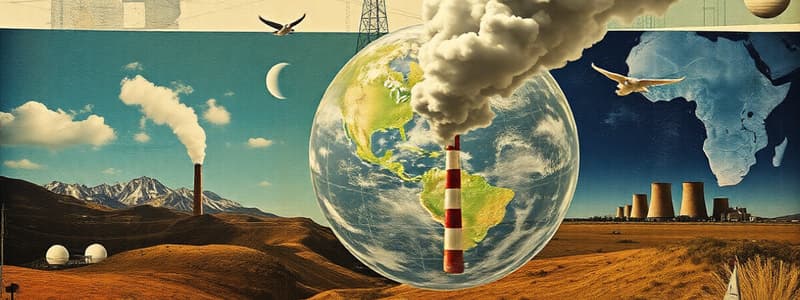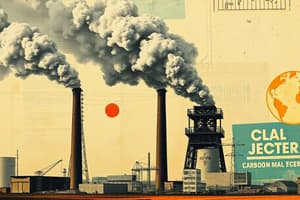Podcast
Questions and Answers
What are the main greenhouse gases responsible for trapping heat in the Earth's atmosphere?
What are the main greenhouse gases responsible for trapping heat in the Earth's atmosphere?
- Water vapor and carbon dioxide (correct)
- Ozone and methane
- Nitrogen and sulfur dioxide
- Oxygen and nitrogen
What effect does the increase of carbon dioxide levels in the atmosphere have on temperatures?
What effect does the increase of carbon dioxide levels in the atmosphere have on temperatures?
- It traps extra heat, causing temperatures to rise. (correct)
- It alters the composition of the atmosphere.
- It has no effect on temperatures.
- It decreases temperatures.
What is the primary component of the Earth's atmosphere by volume?
What is the primary component of the Earth's atmosphere by volume?
- Nitrogen (correct)
- Carbon Dioxide
- Argon
- Oxygen
Which of the following is considered an aerosol?
Which of the following is considered an aerosol?
What percentage of the Earth's atmosphere is composed of oxygen?
What percentage of the Earth's atmosphere is composed of oxygen?
What is land pollution primarily caused by?
What is land pollution primarily caused by?
What effect does solar radiation have on Earth's weather?
What effect does solar radiation have on Earth's weather?
How does air pressure relate to the movement of air molecules?
How does air pressure relate to the movement of air molecules?
Which of the following gases contributes to the greenhouse effect?
Which of the following gases contributes to the greenhouse effect?
Which type of pollution occurs due to contamination from chemicals in the air?
Which type of pollution occurs due to contamination from chemicals in the air?
What happens to solar radiation as it enters Earth's atmosphere?
What happens to solar radiation as it enters Earth's atmosphere?
What source is NOT a typical origin for aerosols?
What source is NOT a typical origin for aerosols?
Where does most of Earth's weather occur in terms of altitude?
Where does most of Earth's weather occur in terms of altitude?
What is the definition of density in the context of air?
What is the definition of density in the context of air?
Which of the following gases is primarily responsible for smog formation?
Which of the following gases is primarily responsible for smog formation?
What effect does atmospheric composition have on sunlight passing through?
What effect does atmospheric composition have on sunlight passing through?
What characterizes the stratosphere in terms of temperature with altitude?
What characterizes the stratosphere in terms of temperature with altitude?
Where is the stratopause located in the Earth's atmosphere?
Where is the stratopause located in the Earth's atmosphere?
Which atmospheric layer is known to be the coldest?
Which atmospheric layer is known to be the coldest?
What significant event occurs in the mesosphere?
What significant event occurs in the mesosphere?
What is the thermosphere known for?
What is the thermosphere known for?
What is the key characteristic of the exosphere?
What is the key characteristic of the exosphere?
Which layer of the atmosphere separates the troposphere from the stratosphere?
Which layer of the atmosphere separates the troposphere from the stratosphere?
What primarily influences temperature gradients in the stratosphere?
What primarily influences temperature gradients in the stratosphere?
What happens to atmospheric pressure as altitude increases?
What happens to atmospheric pressure as altitude increases?
What is the primary characteristic of the troposphere?
What is the primary characteristic of the troposphere?
What is a temperature inversion?
What is a temperature inversion?
What function does a radiosonde serve?
What function does a radiosonde serve?
Which atmospheric layer serves as the boundary between the troposphere and stratosphere?
Which atmospheric layer serves as the boundary between the troposphere and stratosphere?
What does the term 'vertical pressure variation' refer to?
What does the term 'vertical pressure variation' refer to?
How many layers are defined in the structure of Earth's atmosphere?
How many layers are defined in the structure of Earth's atmosphere?
What major role does the exosphere play in the atmosphere?
What major role does the exosphere play in the atmosphere?
What is the primary characteristic of the thermosphere?
What is the primary characteristic of the thermosphere?
Which element is NOT considered a fundamental aspect of weather?
Which element is NOT considered a fundamental aspect of weather?
What does humidity measure?
What does humidity measure?
Which of the following describes precipitation?
Which of the following describes precipitation?
Which of the following is NOT a function of radar technology?
Which of the following is NOT a function of radar technology?
In what scenario is weather defined?
In what scenario is weather defined?
What type of network is a cellular network most commonly associated with?
What type of network is a cellular network most commonly associated with?
Which of the following best defines visibility in the context of weather?
Which of the following best defines visibility in the context of weather?
How does sunshine duration affect weather elements?
How does sunshine duration affect weather elements?
What causes wind within the atmosphere?
What causes wind within the atmosphere?
Which of the following is a characteristic of middle-latitude cyclonic storms?
Which of the following is a characteristic of middle-latitude cyclonic storms?
Which of these is an example of satellite instruments used in weather forecasting?
Which of these is an example of satellite instruments used in weather forecasting?
What feature of a weather map allows future weather predictions?
What feature of a weather map allows future weather predictions?
Why do meteorologists prefer using satellite instruments for studying weather patterns?
Why do meteorologists prefer using satellite instruments for studying weather patterns?
Which selected climate type is NOT included in the basic categories of climate?
Which selected climate type is NOT included in the basic categories of climate?
What is a significant impact of weather in the United States as mentioned?
What is a significant impact of weather in the United States as mentioned?
Flashcards
Stratosphere Layers
Stratosphere Layers
Atmospheric layer with warm air high up and cool air closer to Earth.
Stratopause
Stratopause
Boundary between stratosphere and mesosphere, where temperature peaks.
Mesosphere
Mesosphere
3rd atmospheric layer; coldest layer, where meteors burn up.
Mesopause
Mesopause
Signup and view all the flashcards
Thermosphere
Thermosphere
Signup and view all the flashcards
Exosphere
Exosphere
Signup and view all the flashcards
Tropopause
Tropopause
Signup and view all the flashcards
Atmospheric Layers
Atmospheric Layers
Signup and view all the flashcards
Greenhouse Effect
Greenhouse Effect
Signup and view all the flashcards
Greenhouse Gases
Greenhouse Gases
Signup and view all the flashcards
Carbon Dioxide Rise
Carbon Dioxide Rise
Signup and view all the flashcards
Aerosols
Aerosols
Signup and view all the flashcards
Pollutants
Pollutants
Signup and view all the flashcards
Air Pollution
Air Pollution
Signup and view all the flashcards
Density
Density
Signup and view all the flashcards
Air Pressure
Air Pressure
Signup and view all the flashcards
Earth's Atmosphere Composition
Earth's Atmosphere Composition
Signup and view all the flashcards
Atmospheric Gases
Atmospheric Gases
Signup and view all the flashcards
Solar Radiation Effects
Solar Radiation Effects
Signup and view all the flashcards
Atmospheric Greenhouse Effect
Atmospheric Greenhouse Effect
Signup and view all the flashcards
Solar Energy
Solar Energy
Signup and view all the flashcards
Vertical Structure of Atmosphere
Vertical Structure of Atmosphere
Signup and view all the flashcards
Weather and Climate
Weather and Climate
Signup and view all the flashcards
Atmospheric Extent
Atmospheric Extent
Signup and view all the flashcards
Atmospheric Pressure
Atmospheric Pressure
Signup and view all the flashcards
Vertical Pressure Variation
Vertical Pressure Variation
Signup and view all the flashcards
Temperature Inversion
Temperature Inversion
Signup and view all the flashcards
Radiosonde
Radiosonde
Signup and view all the flashcards
Troposphere
Troposphere
Signup and view all the flashcards
Tropopause
Tropopause
Signup and view all the flashcards
Stratosphere
Stratosphere
Signup and view all the flashcards
Atmospheric Layer
Atmospheric Layer
Signup and view all the flashcards
Mesosphere Temperature
Mesosphere Temperature
Signup and view all the flashcards
Radio Waves
Radio Waves
Signup and view all the flashcards
Weather
Weather
Signup and view all the flashcards
Elements of Weather
Elements of Weather
Signup and view all the flashcards
Temperature (weather)
Temperature (weather)
Signup and view all the flashcards
Air Pressure
Air Pressure
Signup and view all the flashcards
Humidity
Humidity
Signup and view all the flashcards
Precipitation
Precipitation
Signup and view all the flashcards
Sunshine Duration
Sunshine Duration
Signup and view all the flashcards
Wind
Wind
Signup and view all the flashcards
Climate
Climate
Signup and view all the flashcards
Satellite Instruments
Satellite Instruments
Signup and view all the flashcards
Weather Map
Weather Map
Signup and view all the flashcards
Meteorologists
Meteorologists
Signup and view all the flashcards
Impacts of Weather
Impacts of Weather
Signup and view all the flashcards
Middle Latitudes
Middle Latitudes
Signup and view all the flashcards




